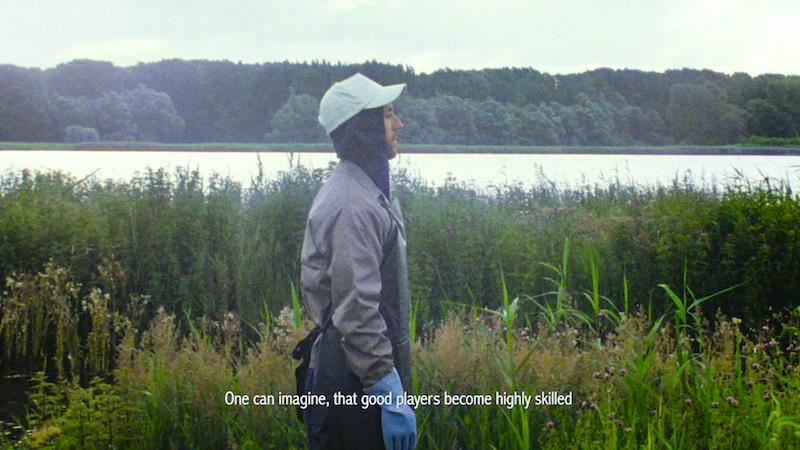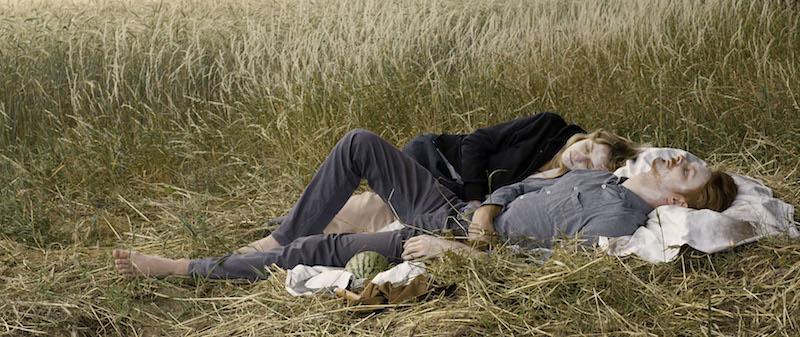 Ani Schulze, Merchants Freely Enter, Video Still, 2017, supported by Kunststiftung NRW
Ani Schulze, Merchants Freely Enter, Video Still, 2017, supported by Kunststiftung NRWall works © Ani Schulze
I met the German artist Ani Schulze at Sitterwerk in St. Gallen, where artists, writers, craftspeople and scientists meet on several occasions, such as open studios, book launches or presentations of current research. Our conversation about the influence of technological developments on the contemporary visual culture, the representation of landscape and the implementation of new ecosystems continued over an artist talk in Zürich and later, during several digital and analogue encounters.
Helene Romakin: Your installation piece “Under the Jaguar Sun” was just now on view in the group show “Obeying Durations” at the 16 Nicholson Street Gallery in Glasgow. Could you tell me more about it?
Ani Schulze: The installation consists of various elements: burning candles, suet energy balls of bird feed, various types of soil, which I collected on former industrial locations in Glasgow and a nine meters long drawing on transparent film, hung into space on a steel and rope structure. The central element of the installation is my video “Merchants Freely Enter” from 2017. All these components build “Under the Jaguar Sun,” which I show in this exhibition in its second version. Usually, I develop my installations site-specific. It was a pleasure to install this particular work in the surroundings of the Georgian building where the gallery is located. I evolved it as a kind of parcours, alluring the viewer to become part of its ecosystem.
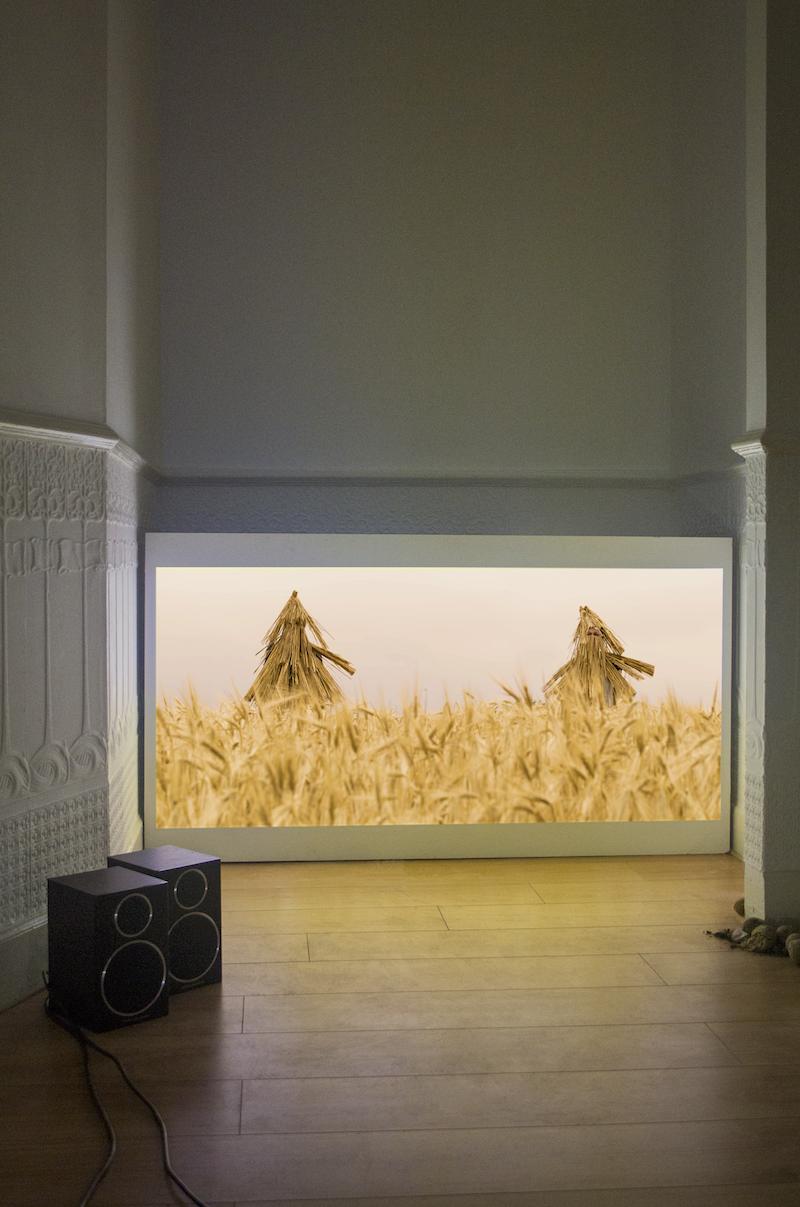
Ani Schulze, Under the Jaguar Sun, Installation detail; Photo: Ben Soedira
HR: Speaking of ecosystems, your work suggests a landscape in a state between post-apocalyptic and not-yet-alive scenario. How do you relate your work to ecology and ecosystems?
AS: Central to my installation works are video elements. They transform places, landscapes and architectural forms into fiction and imaginative spaces. Insofar, they transport narratives, scenarios and speculations of organic living systems in form of virtual media into other spaces, such as exhibitions. They further reflect in themselves the conflation between these representative systems, landscapes and ecosystems with digital means and representations. The first version of “Under the Jaguar Sun” at Schloss Ringenberg was emphasising the 'living system'. The combination of birdseeds and bark mulch evoked the growth of grass, which changed the whole installation also in terms of smell. In this sense, I am not directly interested in ecological issues, although they appear in my work. I am rather curious about the representation of landscapes.
HR: Today, processes of urbanisation, increasing industrialisation and migration to the cities leave rural places abandoned and affect landscapes. Your film “Merchants Freely Enter” shows excerpts of forests, and vast cornfields. How did you choose the sites?
AS: The sites where I shot “Merchants Freely Enter” came up through the residency that I had during this time. For one year, I was based in Schloss Ringenberg, which is situated about 50 km from Dusseldorf in a small village surrounded by fields and forests. This immediate situation was a big benefit for the shooting process of the piece. But it was important that the characteristics of that landscape appeared as ubiquitous as possible. The idea was not to show this specific landscape as a concrete location. Moreover, I chose the sites on a common idealistic picture of contemporary “Western” landscapes and their representation of progress, agriculture and control. That is why, for example, the aerial views of deserted, golden cornfields became so important. For the last part of the video my film team and me literally dived into the swamp next to the castle in a rainy, foggy night. For this episode the idea was to lead the viewer into a mysterious world of a surreal, self-contained nature. Many viewers see multiple things in this part, such as frogs, or other fantastic creatures that have not been at the “real” setting.
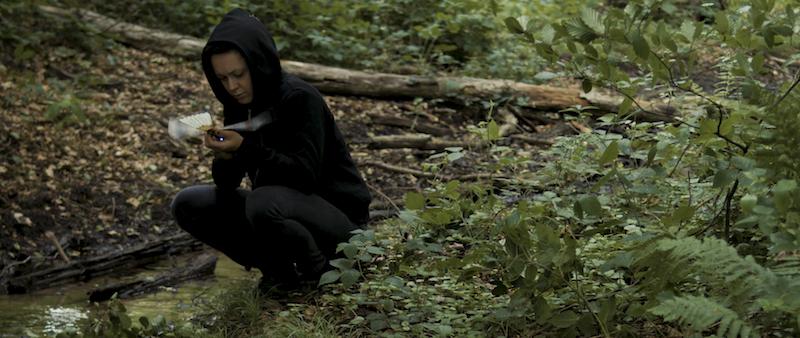
Ani Schulze, Merchants Freely Enter, Video Still, 2017, supported by Kunststiftung NRW
HR: The film is narrated in a slow pace, built up in fragments of high-resolution close-ups. It challenges the viewer used to changing images and slows down the entire surrounding of the installation. What is your concept of time?
AS: “Merchants Freely Enter” enfolds against the backdrop of a notion of a present that is increasingly determined by the past and the future. The video creates—like an image machine—a mesmerising pattern of sound and visual collages, soothing and harrowing in turn. Hybrid and paranormal characters straddle and collapse states between real and artificial, intimacy and distance, dead and alive. Experiencing the time of the sound and the video collage goes hand in hand with experiencing the space. It reflects on the changes for our sense of spatial and temporal orientation, prompted by new technologies. The narrative navigates a longing: The digital revenant of a longing, which returns from the past as a promise of a future that passed before it ever has begun.
Ani Schulze, Merchants Freely Enter, Excerpt, 4K Video, 12min, 2017, supported by Kunststiftung NRW
HR: Bodily experiences of landscape seem central to your work. What is the idea behind the interaction between body and landscapes modified through technology and agriculture?
AS: The figures I create in my recent videos appear in deserted scenarios as members of lost or forgotten societies. For instance, the character of the video “Fecund Soil” (2016) moves lonesome through the surreal setting of an integral nature reserve located next to one of the biggest chemicals clusters in the world. In the first part of “Merchants Freely Enter” two mysterious characters emerge in the forest. They seem to follow ritual actions. Two other figures with hay costumes and masks play out their techniques of camouflage, combined with a dramatic soundtrack. They reflect the idea that technologies of vision have always generated technologies of camouflaging. An important component of experience is the sound, which opens up a further layer and appears as another, invisible body. In combination with aerial views in “Merchants Freely Enter” it implies questions of who is in control of the sight and who is guiding through the images. All of the characters, figures and scenarios navigate through a world of an arcane imagination, archaic appropriation and digital empowerment. They stress interactions between the body and human made landscapes and provoke bodily experiences of proximity and distance, opaqueness and visibility, absence and presence, control and loss of orientation.
HR: Environmental concerns have entered the realm of visual arts, addressing the growing symbiosis between man and machine. How has this relationship changed in the past years?
AS: My recent works explore new technologies for capturing images, such as drones, and their impact on our sight, the representation and control of the present landscape. By exploring the seduction, magic and desperation of these new technologies, I elaborate visual narratives and eclectic assemblages. ”Merchants Freely Enter” creates a juxtaposition of seemingly unrelated events: the video uses aerial views, footage of robotic birds, and a precise technique of a scanning camera to fuse image constructions of landscape surveillance with the picturesque memory of a grilled chicken in a picnic scenery in style of a historical painting. Collages like these generate commonly shared anxieties and longings.
HR: As your practice articulates an urgency regarding environmental issues, how do you relate to activism?
AS: My recent work tackles societal constructions of culture and wilderness or sublime, untouched nature. I am mostly concerned in how natural systems are drawing closer to an endpoint, and how successful societies drift toward self-destruction. Landscapes embody these paradoxes and I am curious about their representation. I don’t want to show or present something as good or bad, wrong or right. I rather urge to show the complexities, interrelations and influences.
HR: In June 2018 we realized the artist talk “In The Free Fall” at the Berta’s Kitchen Talk in Zurich, which you transformed into a performance including the presentation of film clips, performative reading and documentation of recent shows. Could you explain this part of your practice?
AS: The artist talk was similar to a presentation I gave at Kölnischer Kunstverein in November 2017. The idea was to narrate a feeling or the experience inherent to my work, instead of just describing my practice. It was based on a visual collage, enfolding a narrative of a few chapters. The talk was based on a massive collection of texts and visual materials: I collected agricultural technology commercials – primarily from the USA and Canada – such as for tractors and other machines. The found footage is amazing. Drone flights hovering above tractors show vast landscapes; the tractors form choreographies and patterns; meanwhile chopping wheat and maintaining the fields. I edited these sequences and fused them with other text or image based materials. These new collages, which navigate through forces of gravity, cornfields, surveillance panoramas or imagery of my own works, create confusion between the found footage and my own work. They generated new rhythms, almost meditative or psychedelic. I want to keep evolving this format of “performative reading.”
HR: Your interdisciplinary work could be regarded as artistic research. Do you collaborate with scholars from other disciplines?
AS: Recently, I worked with engineers concerned with biotechnology developing new monitoring drones, with an ornithologist taking care of a natural reserve in Antwerp and an invigilator of a decaying modern architectural space in Strasbourg. These acquaintances directly feed back into the narrative constructions of my work or they impersonate a character in my videos. Therefore, the distinctive features of these personalities interweave with their scripted characters. The invigilator plays himself in the video “From Aerial Vortices” while in the video he also transforms to a half-forgotten figure of the “Western” avant-garde.
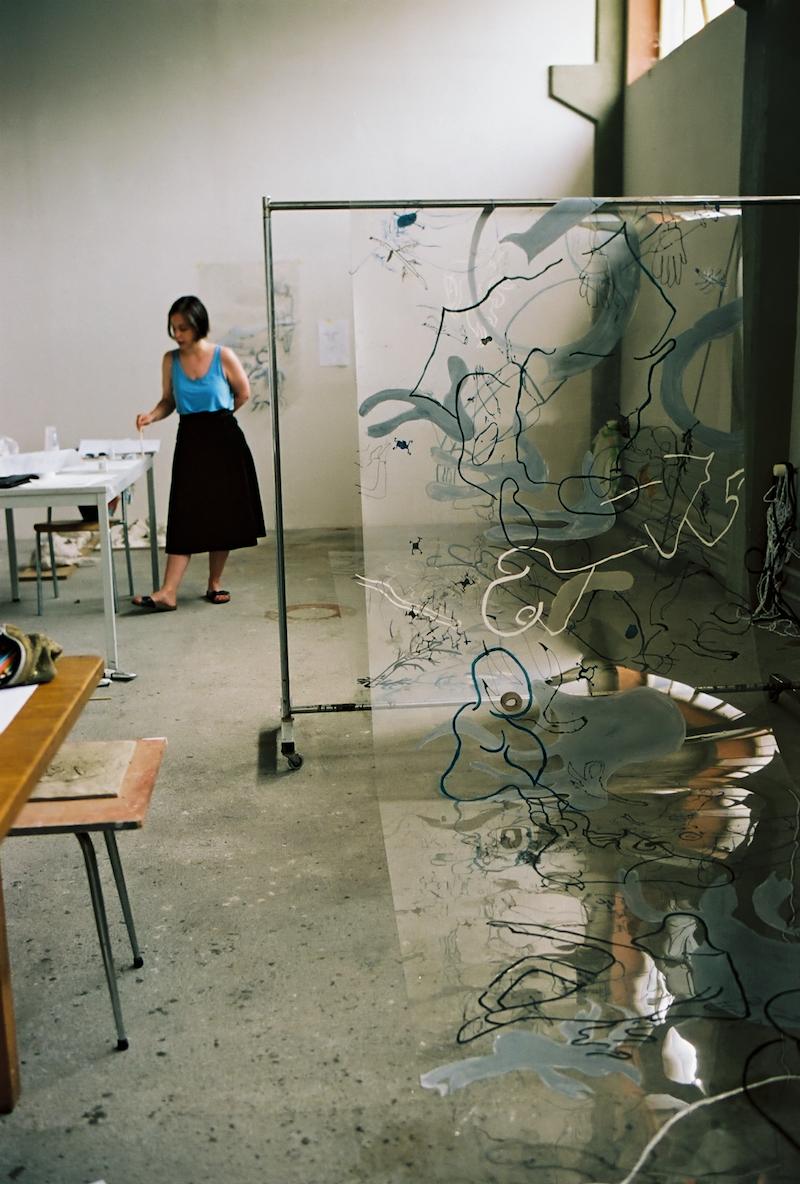 Ani Schulze in the guest studio of Sitterwerk in Sankt Gallen, 2017, Photo: Katalin Deér
Ani Schulze in the guest studio of Sitterwerk in Sankt Gallen, 2017, Photo: Katalin Deér
HR: You are currently living a nomad life, engaging in different site-specific, cultural scenes for example during a residency in Schloss Ringenberg, one in Brussels and another at the Sitterwerk St. Gallen. How do you think these experiences influence your work?
AS: Every place influences my work in various and inimitable ways. My residency at the Sitterwerk guest studio was very unique: Working and living in the valley with its foundry, library, Josephson’s Kesselhaus and all the fantastic people, I developed a series of new ceramics and created the nine meters long drawing for the 16 Nicholson Gallery show. Sometimes the influences of different places are very direct and immediate —as in the choice of shooting sites for the making of “Merchants Freely Enter.” Also, the video “Fecund Soil,” which I filmed in 2016 in an integral natural preserve next to one of the biggest chemical clusters in the world in the harbour of Antwerp, benefited from a three month residency at AiR Antwerpen in collaboration with Basis, Frankfurt. Encounters at these locations influence not only the settings of my projects, they especially effect exchanges and collaborations. Sometimes specific research, such as my explorations in the archives of the Tervuren, Royal Museum for Central Africa in Brussels, connect to projects I have been realising before. I very much enjoy developing my work within different places and in exchange with various people. I see it as a big privilege to be that nomadic and on the move so much.
anischulze.net
anischulze.net

